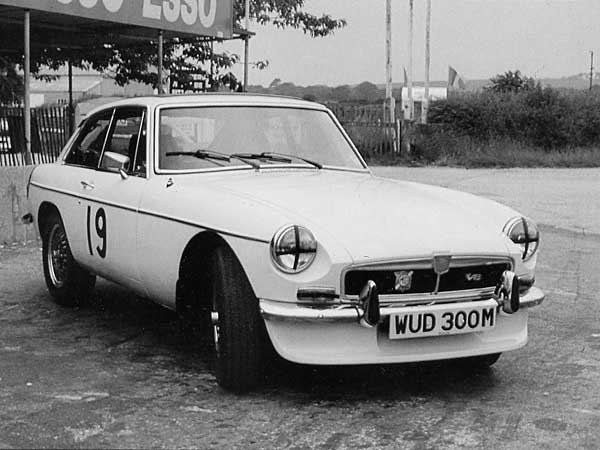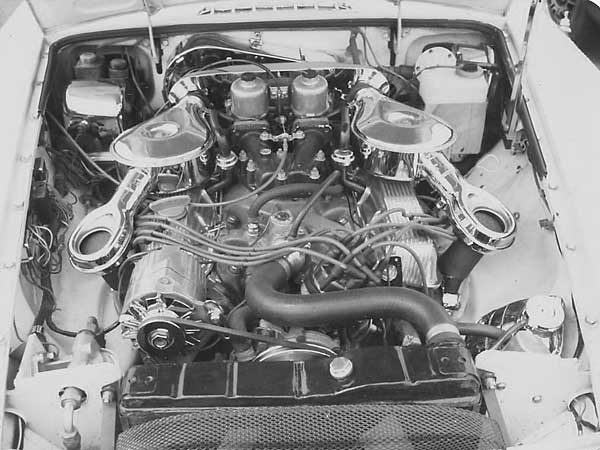�

�
MGB improves with V8's increased torque
�Road Test: MGB GT V8
��
as published in British V8 Magazine, Volume XVI Issue 1, May 2008�
�
Re-printed unedited by exclusive written permission of "Autosport".
�
This article originally appeared in their issue for the week ending December 27, 1973.�
�
by John Bolster�
�
�
The MGB has been with us for many years and is typical of traditional British sports �
cars. In its GT form, it has a practical coupé body with a tailgate for luggage, �
which greatly widens its appeal. However, the basic design is still of vintage �
simplicity and refinement is not its strong point.�
�
Now, British Leyland are offering an additional model, with a very refined V8 engine �
that almost doubles the torque and power output of the usual 1.8-litre 4-cylinder unit. �
This is the light-alloy engine of the Rover 3500, but modified for the MG installation, �
particularly in the induction department where the penthouse manifold is replaced by a �
low-level one, with the carburettors to the rear of the block. This completely avoids �
an unsightly bulge in the bonnet, which would restrict the driver's view.�
�
The V8 is actually lighter than the four, but USA and other foreign regulations call �
for anti-pollution and silencing equipment which adds appreciably to the weight and �
slightly restricts the power output. A larger radiator with two electric fans is used �
and an oil cooler is also fitted. A bigger clutch handles the torque and the MGC gearbox �
has been beefed up and furnished with closer ratios. The rear axle has also been �
strengthened and the ratio has gone from 3.91 to 3.07 to 1. Some stiffening of the �
springs has also taken place. A Laycock overdrive is fitted as standard. �
�

�
The road holding is very safe indeed and entirely predictable this being �
an easy car to drive fast on winding roads.�
�
If one does not notice the V8 motif, the more powerful version of the MGB is �
indistinguishable from its four-cylinder sister. Even in the driving seat, the only �
clue is the smaller speedometer and rev-counter dials, necessitated by the collapsible �
safety steering column. As soon as the quiet engine is started, however, it is obvious �
that this is a very different machine.�
�
Because the engine is so unobtrusive, the car does not feel as fast as it is. Yet, it �
has a performance in the upper speed ranges which the 1.8-litre model, rather naturally, �
cannot approach. About 124 mph is possible in direct top gear, with the rev-counter just �
going into the red, or the same speed may be achieved on overdrive with the engine well �
within its range. Overdrive will give an extra 1 mph or so on the level and a bit more �
under favourable conditions, well below the red part of the dial. The engine is never �
noisy but it is even quieter when the overdrive is engaged for high-speed cruising.�
�
The overdrive also permits fuel economies, which is certainly its greatest virtue nowadays. �
At a steady 50 mph, the car gives 30 mpg in direct drive and 32 mpg in overdrive. At �
70 mph, the respective figures are 25.6 and 27.5, while at 100 mph they are 16.9 and �
20 mpg. On winding roads and in traffic, the eight-cylinder model may be just about as �
economical as the four since less gear-changing is required. �
�
Because the engine is so smooth and quiet, the rest of the car perhaps shows up less �
well. The gearbox is audible when on the indirects and there is road noise on some �
surfaces. The wind noise is rather obtrusive at high cruising speeds, once again because �
it is not drowned by engine roar. The former tendency of the windows to bulge under high �
wind pressure has been overcome, but at the expense of making slamming essential when �
the doors are closed. �
�
The suspension is definitely hard and the ride choppy, especially at moderate speeds. �
On the other hand, the roadholding is very safe indeed and entirely predictable, this �
being an easy car to drive fast on winding roads. There is really no difference in �
handling between this and the ordinary MGB, except that the tail can come round fairly �
smartly if one over-accelerates out of a sharp bend. The offside rear wheel spins very �
easily, due to propshaft torque tending to lift one end of the axle and depress the �
other, so a limited-slip differential might be a worthwhile extra. �
�
Enjoying this article? Our magazine is funded through the generous support of readers like you!
�
To contribute to our operating budget, please click here and follow the instructions.
�
(Suggested contribution is twenty bucks per year. Feel free to give more!)�
�
The brakes are powerful with a light pedal action, giving plenty of instant bite for �
emergency stops. The gearchange, though, tends to be heavy and first gear can be �
difficult to engage at rest. This effect seems to be more noticeable when the box gets �
really hot during prolonged traffic driving. While I am being critical, I should mention �
that the heater is not very powerful and the spoke of the steering wheel can obscure �
the blue light indicating that the headlights are on main beam. �
�
Quite wide doors make entry easy and the seats are comfortable. Behind the seats is a �
padded compartment, suitable for a dog or a baby. The main luggage space is approached �
by lifting the tailgate, which gives excellent accessibility but not much privacy for �
one's suitcases. Regarded purely as a 2-seater, the MG can carry enough impedimenta for �
the most prolonged continental tour. �
�

�
The Rover 3.5-litre V8, surely the most versatile engine that has yet been built. �
�
The bonnet could scarcely be fuller of engine and ancillaries. Nevertheless, the main �
items which are likely to need attention are quite get-atable. The electric radiator �
fans never come into action on the open road, but when they start while the quiet engine �
is idling they produce a surprisingly loud hum. Though the body shape stems from 1965, �
it has a pleasantly functional look which has not really dated and the new Dunlop wheels, �
with ventilated light-alloy centres, enhance its appearance. �
�
Technically, the MGB GT V8 is perhaps new wine in an old bottle. It gives a harder ride �
than one would get with the latest suspension systems, but its vintage handling �
characteristics are beloved of -many enthusiasts. It's small enough to be nippy in �
traffic and it is not burdened with a long bonnet, that curse of the traditional British �
sports car.�
�
Surely the Rover 3.5-litre V8 is the most versatile engine that has yet been built. It �
works marvels in the Range Rover and it turns the staid old MGB into a 125 mph flyer. �
To substitute a modern piece of light-alloy engineering for an olde tyme cast-iron lump �
must be progress, and the resulting sports car is no hybrid but an excellent performer �
with moderate fuel consumption. �
SPECIFICATION AND PERF0RMANCE DATA
��
Car tested: MGB GT V8 2-door coupe, price £2293.96 including car tax and VAT.�
�
Engine: Eight-cylinder 88.9 mm x 71.12 mm (3528 cc). Compression ratio 8.25 �
to 1. 137 bhp (net) at 5000 rpm. Pushrod-operated overhead valves with hydraulic �
lifters. Twin SU carburetors.�
�
Transmission: Single dry plate clutch. 4-speed all synchromesh gearbox with �
Laycock overdrive, ratios: 0.820, 1.0, 1.259. 1.974, and 3.138 to 1. Hypoid rear axle, �
ratio: 3.071 to 1.�
�
Chassis: Combined steel body and chassis. Independent front suspension with �
wishbones, coil springs, anti-roll bar, and lever-type dampers combined with top �
links. Rack and pinion steering. Live rear axle on semi-elliptic springs with �
lever-type dampers. Servo-assisted disc front and drum rear brakes. Bolt-on cast �
aluminum wheels with chromed steel rims, fitted 175 HR 14 radial tyres. �
�
Equipment: 12-volt lighting and starting. Speedometer. Rev-counter. Oil �
pressure, water temperature, and fuel level gauges. Heating, demisting, and �
ventilation system, with heated rear window. 2-speed windscreen wipers and washers. �
Flashing direction indicators. Reversing lights. Cigar lighter. Radio (extra). �
�
Dimensions: Wheelbase 7 ft 7.125 ins. Track (front) 4 ft 1in (rear) 4ft �
1.25 in. Overall length 12 ft 10.75 in. Width 4 ft 11.94 ins. Weight 1 ton 1 cwt. �
�
Performance: Maximum speed (overdrive) 125 mph, (direct top) 124 mph. �
Speed in gears: Third 99 mph, second 64 mph, first 41 mph. Standing quarter-mile �
16.5 s. Acceleration: 0-30 mph 3.0 s. 0-50 mph 6.5 s. 0-60 mph 8.3 s. 0-80 mph �
15.2 s. 0-100 mph 26.6 s.�
�
Fuel consumption: 20 to 28 mpg. �
�
�
When Autosport originally published this article, they illustrated it with five black-and-white �
photos of a dark colored MGB GT V8 bearing registration plate "HOH 932L". Our copies �
of these photos aren't in suitable condition for reproduction. We've substituted two photos from �
Ken Smith's personal collection, displayed above with two of the five original captions. The �
following captions were also included in the original lay-out:
�
(side view of the car, in motion)
�
"If one does not notice the V8 motif, the more powerful version of �
the MGB is indistinquishable from its four-cylinder sister."
�
(steering wheel and instrument panel)
�
"The only mark distinquishable from its four-cylinder sister is the smaller �
speedometer and rev-counter dials, necessitated by the collapsible safety steering column."
�
(exterior rear with woodland background)
�
"The offside rear wheel spins very easily due to propshaft torque tending to �
lift one end of the axle, and depress the other."�
�
� BritishV8 Magazine has assembled the largest, most authoritative collection of MG � "MGB GT V8" information you'll find anywhere. Check it out! � Access our � MGB GT V8 article index by clicking here. �
�
